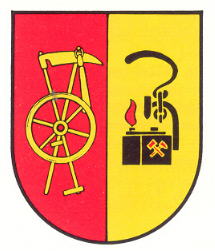Dunzweiler: Difference between revisions
Jump to navigation
Jump to search
Knorrepoes (talk | contribs) No edit summary |
Knorrepoes (talk | contribs) |
||
| Line 26: | Line 26: | ||
The arms were officially granted on November 30, 1982. | The arms were officially granted on November 30, 1982. | ||
The arms indicate the (economic) transformation of the village. Initially an agricultural village (scythe and flail), later more home (textile) industry developed (spinning wheel) and in the 19th century coal mining became the main activity (miner's lamp). | The arms indicate the (economic) transformation of the village. Initially an agricultural village (scythe and flail), later more home (textile) industry developed (spinning wheel) and in the 19th century coal mining became the main activity (miner's lamp and tools). | ||
The red and golden colours are taken from the arms of the Counts of Zweibrücken, to which the area belonged for many centuries. | The red and golden colours are taken from the arms of the Counts of Zweibrücken, to which the area belonged for many centuries. | ||
Revision as of 06:45, 21 July 2023
|
Country : Germany State : Rheinland-Pfalz District (Kreis) : Kusel Verbandsgemeinde : Oberes Glantal (until 2017 Waldmohr)
|
| German | Von Rot und Gold gespalten, rechts eine goldene Sense und ein goldener Dreschflegel gekreuzt, belegt mit einem sechsspeichigen goldenen Rad, links eine schwarze Grubenlampe (Grubenfrosch) mit roter Flamme und belegt mit zwei gekreuzten goldenden Bergwerkshämmern. |
| English | blazon wanted |
Origin/meaning
The arms were officially granted on November 30, 1982.
The arms indicate the (economic) transformation of the village. Initially an agricultural village (scythe and flail), later more home (textile) industry developed (spinning wheel) and in the 19th century coal mining became the main activity (miner's lamp and tools).
The red and golden colours are taken from the arms of the Counts of Zweibrücken, to which the area belonged for many centuries.
Literature: Debus, 1988




